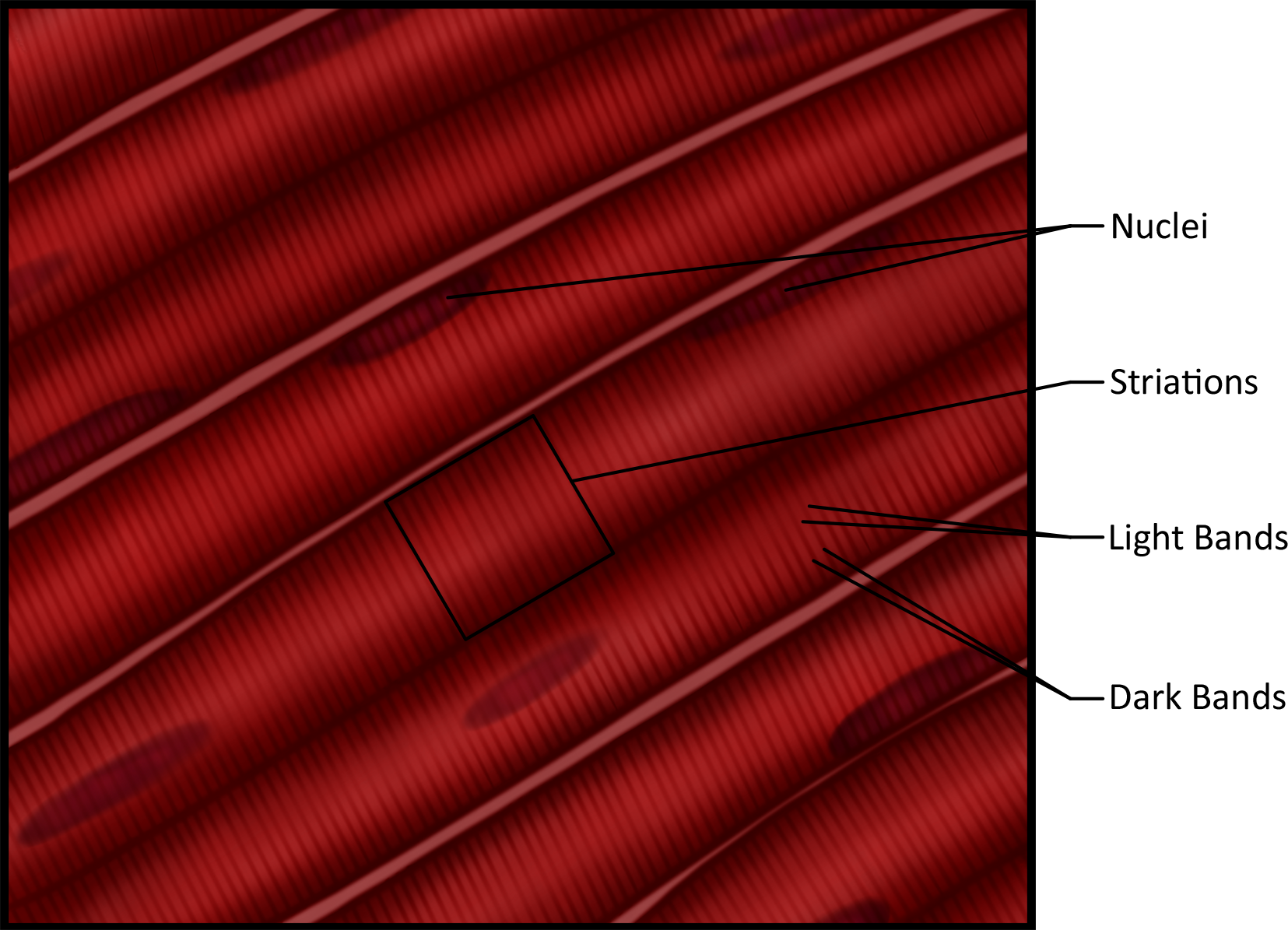
(a)
Structure and Functions of Muscle Tissue
Anatomy & Physiology I
If I were to ask you to point to a muscle, right now, most of you would point to one of your skeletal muscles like the biceps brachii, rectus abdominis, or even the gastrocnemius. While skeletal muscles are the most familiar, they are only one of the types of muscle that are found in your body. There are in fact 3 different types of muscles that are all structurally different from one another. Because of this difference in structure there is a distinct diversity in function. Simply put, the 3 different types of muscle all look different, so they have very different jobs.
First, we have already mentioned skeletal muscle. Skeletal muscle is named because it moves your skeleton and we utilize this muscle mainly for locomotion and support of the body. This type of muscle is under voluntary control, which means that your brain controls the contraction. For instance, if you want to flex your arm and show off your biceps brachii, you can do so simply with a thought or intention of the movement; similar to: you think, therefore you do. These muscles are striated, or striped, due to the organization of intracellular proteins into units. Because the proteins are so highly organized and the units repeat, a striped appearance of this tissue results. These muscle cells are also multinucleated meaning that each cell has more than one nucleus. The biggest question asked here is WHY? Muscle cells are also known as muscle fibers, because they are extremely long cylindrical cells. One cell can run the entire length of a skeletal muscle, growing up to 30 cm in length (think of how long a giraffe's neck muscle fibers may be). With a cell being that expansive, there must be more than one control center (nucleus) to make sure the cell is functioning properly and maintaining homeostasis. During development, mesoderm differentiates into myoblasts (progenitor cells, each with its own nucleus) that then fuse together to create a larger, more elongated multinucleated skeletal muscle cell.

(a)
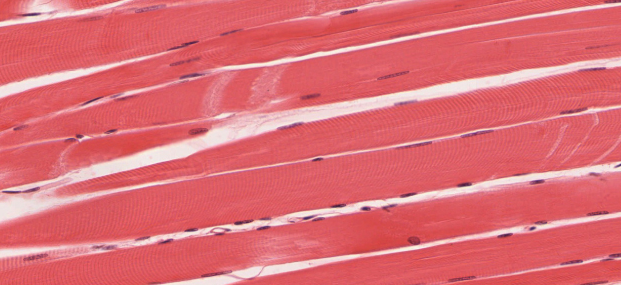
(b)
Figure 1. (a) This image depicts skeletal muscle cells; note the dark and light bands, striations and nuclei (b) An actual micrograph of skeletal muscle.
Cardiac muscle is named because it is found in the heart and we utilize this muscle to pump blood all over the body through the circulatory system. These muscle cells are also striated, like skeletal muscle, meaning that the organization of the proteins within a cardiac muscle cell mimics that found in a skeletal muscle cell. Due to these structural similarities, when you learn how a skeletal muscle contracts to cause movement you will then be able to adopt that knowledge to understanding cardiac muscle cell contraction. Even though there are similarities that exist between cardiac and skeletal muscle structure there are also great differences. Cardiac muscle cells are much shorter than skeletal muscle fibers, and because of this only have one nucleus instead of multiple. These cells are often branching creating a crisscross cell arrangement in the myocardium (cardiac muscle wall). This crisscross arrangement helps to effectively move the blood out of the heart into the awaiting blood vessels. These smaller cells must be connected so that they receive the proper signals and contract in a synchronized manner. The areas where 2 cells are joined are called intercalated discs and can be seen clearly in histology slide below. These discs contain desmosomes, junctions that hold the cells together (much like a zipper in a dress) and gap junctions, that allow the cells to directly communicate with each other.
Cardiac muscle is under involuntary control, meaning that you cannot control your heart rate to any great degree simply by thinking about it. The heart beats not because of conscious thought or intention but rather due to its own unique intrinsic properties and the autonomic nervous system. This is very beneficiamicrograph next to sketchl because as you sit reading this your heart continues to beat. If you had to tell it to beat each and every time it did so, you would not be able to enjoy this text or sleep at night without fear of missing several beats and incurring disaster. You will delve more into this fascinating phenomenon during the circulatory system chapter.
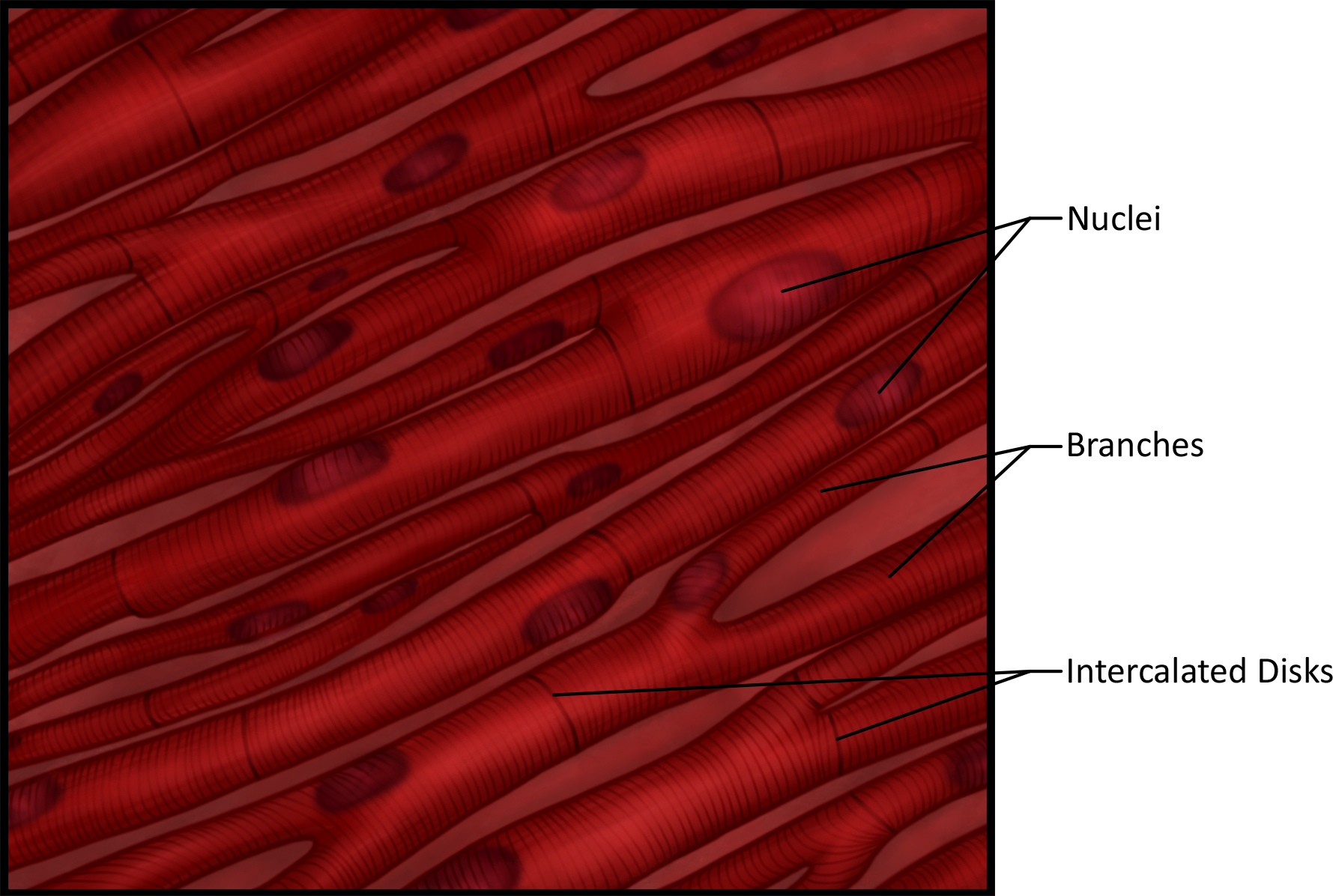
(a)
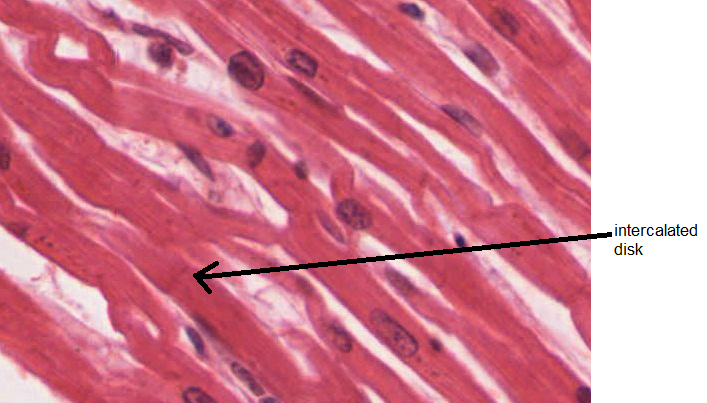
(b)
Figure 2. (a) This image depicts cardiac muscle cells; note the striations, branching nature and interacalated discs (b) An actual micrograph of cardiac muscle.
Lastly, smooth muscle fibers are named for their homogenous appearance, meaning that the cells look uniform throughout and do not have striations. This leads us to infer that because they are not organized in the same way that skeletal and cardiac muscle is organized, their method of contraction is different from what you will learn in this unit. Instead of the muscle cell shortening when it is stimulated, smooth muscle cells twist and bunch when stimulated. Visualize holding bread dough in your hands, placing one hand at either end of the dough. If you move your hands toward each other the dough shortens into rounded configuration - this is how skeletal and cardiac muscle contract. If you begin to twist the dough and move your hand toward each other forming a compacted spiral you have now mimicked how smooth muscle contracts. This is because the proteins responsible for contraction are not organized into repeating units but rather are located around the periphery of the cell like a net. The regulatory protein in smooth muscle is also different, utilizing calmodulin and myosin light-chain kinase instead of troponin.
Smooth muscle is widely distributed throughout the body and found primarily in the walls of hollow organs such as blood vessels, the digestive system, the iris of the eye, urinary bladder, etc. This muscle, like cardiac, is also under involuntary control and the function varies depending on the location of the smooth muscle. Remember, involuntary means that you cannot control the muscle actions to any great degree. If you stand in front of the mirror with an unchanging light source regardless of how hard you think, "pupil constrict," they will not do so.
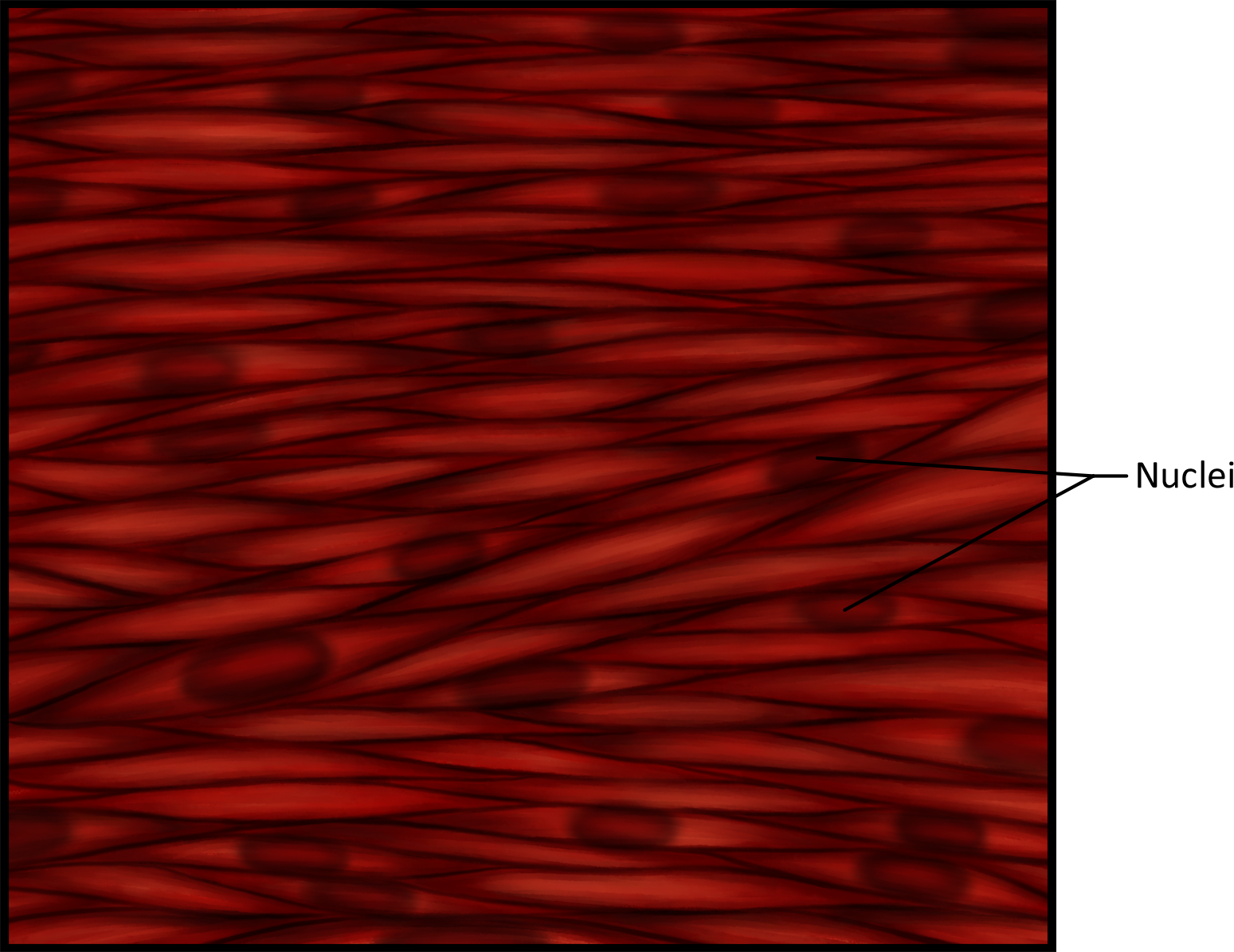
(a)
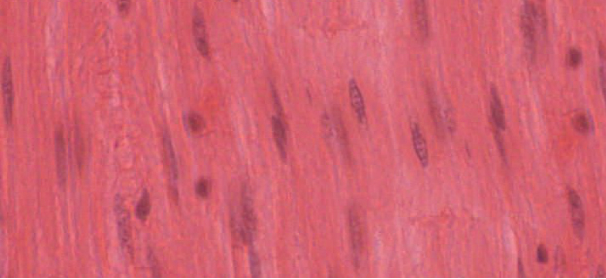
(b)
Figure 3. (a) This image depicts smooth muscle cells; note the nuclei (b) An actual micrograph of smooth muscle.
| Type of Muscle | Histology | Location | Structure | Function | Control |
|---|---|---|---|---|---|
|
Skeletal |
|
Attached to the skeleton |
Striated and Multinucleated |
Locomotion, thermogenesis, support the body, and move lymph through vessels.
|
Voluntary |
|
Cardiac |
|
Heart |
Striated, branching cells with only one nucleus, cells are connected at intercalated discs.
|
Pump blood through circulatory system
|
Involuntary |
|
Smooth |
|
Widely distributed: inside hollow organs, attached to hair follicles, etc. |
Homogenous in appearance, small cells with only one nucleus. |
Function depends on muscle location |
Involuntary |
Although there are marked differences between all 3 types of muscle tissue, there are some properties that they share. First and foremost muscle cells, like all cells we have previously studied, are contained by a cell membrane. The cell membrane, or sarcolemma, serves as a barrier to distinguish what is outside versus what is inside the cell. Inside the cell many proteins, mitochondria, DNA, and RNA are contained, all of which have a negative charge. There is also potassium (K+) inside the cell but not enough to overcome the negative charge of the much larger and more common molecules. Therefore, the inside portion of the cell membrane bi-layer is negatively charged. Outside of the cell there are numerous cations such as calcium (Ca2+) and sodium (Na+) that confer a positive charge to the outside portion of the cell membrane bi-layer. This means that there is a difference of charge across the cell membrane since the inside portion is negative and the outside portion is positive. The transmembrane charge difference means that the membrane is said to be polarized. This polarization is furthered by the presence of sodium potassium pumps (Na+K+ ATPase) in the membrane which unequally distributes cations. Remember, this particular pump transports 3 positively charged sodium ions out of the cell and only 2 positively charged potassium ions into the cell. With each turn of the pump the inside of the cell loses 1 positive charge (3 out - 2 in = 1 less positive charge inside the cell than it started with); thereby reinforcing the polarization of the membrane.
Animation 1. View the Sodium Potassium Pump animation on YouTube (opens in new window). Note not only the direction of the ion movement, but how each turn of the pump makes the inside of the cell progressively more negatively charged.
The first functional property that all 3 muscle types share is called excitability. Excitability is the ability of a cell to change its inner-membrane charge to a more positive charge (depolarization) in response to a stimulus. As we will discuss shortly in the section about the neuromuscular junction, when a stimulus is received signaling that it is time for the muscle to contract, the polarized cell membrane exchanges charges across the membrane due to an influx of positively charged ions. This makes the inside bi-layer of the cell membrane positive (where it was originally negative) in a process called depolarization (when charges flip from negative to more positive inside and less positive outside). When the stimulus is removed the membrane returns back to its original polarized state. Excitability is the functional property that allows us to turn on certain muscles when they need to be used and turn them back off when we don't need them, saving many resources and giving us control over certain aspects of body function. Additionally, this property is not unique to muscle cells. Neurons are also excitable and can undergo depolarization in response to a stimulus. Often times the stimulus is external and actives depolarization in the nervous system which will cause depolarization in the muscle cells and evoke a response. It might sound complicated but it happens all day and you are often not aware of it occurring.
Another functional property is that all muscle cells are contractible. Contractibility is the ability of a muscle cell to contract or shorten. The shortening movement causes force production which in turn is used for that particular muscle's function, including locomotion, pumping blood, or changing the size of your pupil. This functional property is made possible because of movement within the cell of the contractile proteins actin and myosin. There is more depth on this topic to come.
A third functional property is that all muscle cells are compliant. Compliance is the ability of a muscle cell to stretch. Compliance is often called extensibility - because the muscle can be stretched or extended. Muscles are capable of contracting over a variety of lengths but the amount of tension produced will vary depending on the length of the muscle cell. This property is often confused with the last functional property, elasticity. Elasticity is the ability of a muscle to return back to its original size during relaxation. Both of these properties are due to the elastic fibers in the skeletal muscle. To visualize these 2 properties, imagine holding a rubberband in your hands (or grab one if it is nearby). When you stretch that rubberband, you are demonstrating compliance. When you release the rubberband and it snaps back to its original length, that is elasticity. These 2 properties have an inverse relationship to one another. If a muscle has a high compliance, than it will have very little elasticity. Meaning it will stretch easily but not recoil back to its original length quickly. The opposite is true as well. Watch the animations below so see an example of this inverse relationship in action.
Animation 2. View the Compliance and Elasticity animation on YouTube (opens in new window).


Except where otherwise noted, this work by The Community College Consortium for Bioscience Credentials is licensed under a Creative Commons Attribution 4.0 International License.
Text from BioBook licensed under CC BY NC SA and Boundless Biology Open Textbook licensed under CC BY SA.
Other text from OpenStaxCollege licensed under CC BY 3.0. Modified by Alice Rudolph, M.A. and Andrea Doub, M.S. for c3bc.
Instructional Design by Courtney A. Harrington, Ph.D., Helen Dollyhite, M.A. and Caroline Smith, M.A. for c3bc.
Media by Brittany Clark, Jose DeCastro, Jordan Campbell and Antonio Davis for c3bc.
.
This product was funded by a grant awarded by the U.S. Department of Labor's Employment and Training Administration. The product was created by the grantee and does not necessarily reflect the official position of the U.S. Department of Labor. The Department of Labor makes no guarantees, warranties, or assurances of any kind, express or implied, with respect to such information, including any information on linked sites and including, but not limited to, accuracy of the information or its completeness, timeliness, usefulness, adequacy, continued availability, or ownership.